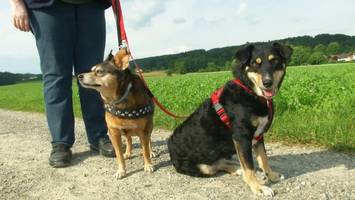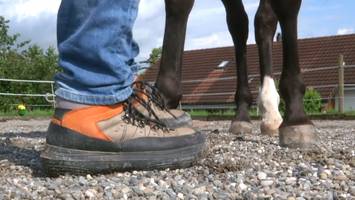Pain despite kybun
You may experience initial reactions when you first use the kybun shoe or mat. On the one hand, your existing pain may worsen, and on the other, complaints may arise in a part of your body that had previously been symptom-free. It is possible that complaints suddenly arise after two or three months in the kybun shoe even though there was previously no indication of a problem, or if there were problems, they affected another part of the body.
This is usually due to the body’s initial reactions to the still-unfamiliar kybun training. More information about this phenomenon and what you can do about it is contained in this text.
Definition
Causes
- The springy, elastic material of the kybun shoe/mat ensures that almost the entire musculature of the body is forced to actively work. As a result, the body is constantly in motion in order to maintain balance and remain upright. This is intense exercise, especially at first. If the body is already impaired as a result of operations or injuries, or if its load-bearing capability is uneven, the kybun shoe provides an additional stimulus and can therefore lead to an intensification of pain (initial reactions). That is why the duration of use (dosage) is particularly important at the beginning.
It is also important to be aware that the kybun shoe automatically forces the body to reduce its reliance on relieving postures and to distribute load evenly. This means that muscle groups may initially be overtaxed and react with pain or soreness. - Attention! Short-term effects are often confused with lasting effects. The adjustment processes in the body triggered by the kybun shoe can take months or even years. Achieving lasting change is a protracted process. Despite that, the effect of the springy, elastic material can also be felt quickly, for example in the relaxation of tense muscles and the alleviation of pressure points. These short-term effects must not be confused with the effects in the long run, since the long-term adjustment process cannot progress far enough in a week to be perceptible.
Short-term effects, on the other hand, can disappear again just as quickly as they came, or can even turn into complaints if you do not take the necessary breaks in the beginning.
This makes it important to understand that an initial reaction and a reduction of the positive feeling in the first few weeks with the kybun shoes does not mean that the kybun shoe is no longer working, but merely that the short-term sense of well-being is declining! - The body’s adaptation processes proceed incrementally and can take months or years. The body begins to rehabilitate one area (usually the one that requires the most attention) and when it is finished there, it is often the turn of another area. This continues until the body is back in shape. This means that working with the kybun shoe/mat can cause pain in parts of the body have never caused trouble before.
- Here is a practical illustration:
kybun ‘activates’ the feet, changing posture, which changes the load on the hips and lumbar column. This is a continuing process and might mean that the hips cause pain or even irritation after two or three weeks, or that the neck suddenly starts causing problems after five or six weeks. But these are all temporary phenomena with which the body is trying to say, ‘Stop! I need a break and time to adjust. Please reduce my workload.’
Long-term consequences
Conventional therapy
The kybun principle of operation – being proactive
Initial reactions
kybun exercises
Application tips
- Since the pain may vary, kybun shoe training should always be adapted to the user’s condition each day. It is important that the affected individual finds out over time how much kybun training is helpful and when it is time for a break in order to avoid increased pain afterwards. On some days, it may well be that only short and gentle kybun shoe training is required (or even skipping a day), while walking longer distances in the kybun shoe may be possible on other days.
There should never be increased pain after kybun shoe training/walking (dosage!).
This is of particular importance with all inflammatory diseases! With regular walking in the kybun shoe, the body will adjust over time (stronger muscular and connective tissue, more stable joints). Complaints/initial reactions will occur less quickly and frequently.More helpful tips:
- If you feel pain in the kybun shoe or on the kybun mat, or if your existing pain gets worse, this may be due to various reasons (e.g. an unfamiliar, more upright posture, tense muscles, movements that are unfamiliar for the body).
- We advise you to perform the kybun exercises regularly every now and again. They loosen the muscles and straighten the body. This relieves strain on the joints. As a result, the pain should decrease after a few hours or days.
Choose the kybun exercises that are good for you! Some customers prefer easier movements while others find the more intensive exercises helpful; this is highly individual. - Choose a kybun shoe with a lower rebound effect. It provides you with greater midfoot stability. Ask your kybun dealer to show you the various models.
- If you feel unstable wearing the kybun shoe or are looking for an additional training device to use at home, the kybun mat is the ideal alternative. You can strengthen the foot, leg and back musculature at home on the springy, elastic mat. You can hold on to a fixed object if you feel unstable. The kybun mat is also available in a choice of different thicknesses (the thicker, the more intensive the training). Ask your local kybun dealer for advice.
- If you get very fatigued in spite of the kybun exercises, or if you feel pain or in case of lateral/medial rolling of the ankle joint on the kybun sole, we advise you to take a short kybun shoe/mat break until the symptoms go away.
- Be sure to maintain an upright posture, avoid taking excessively long stepsandkeep your gaze forward(do not look at the floor). You should walk straight on the kybun sole and correct any lateral/medial rolling of the ankle joint!
Opinions/customer testimonials
I’m so impressed with these shoes. I used to have a heel spur and I’ve actually lost track of all the places I tried before resorting to private treatment. Let me tell you straight up that it was ridiculously expensive. I tried everything that my health insurance would cover and honestly, I was going around with a really bad heel spur for a year and a half. I just didn’t know where to go in the end. My husband and I really love hiking. But I just couldn’t go anymore so he had to go alone, which really upset me. I always thought that there must be something else out there and then I discovered this shop. I thought, ok, I’ll have a look and then I ended up buying the shoes. I had some minor problems with them in the beginning because I had an inflammation in my foot. Once that cleared up, it only took four days for the pain in my feet to go away. I think I’ve had these shoes for about three months now and they’re still the only ones I wear. I highly recommend them. I’m so impressed! For me, these shoes are the best thing since sliced bread!
At first it was difficult to break in the shoes. I could only walk in the shoes for 5 minutes a day and now, after 4–6 months, I can walk in the shoes for over a day. When I walk, my legs don't feel heavy any more. In the evening I lie in bed and my back is relaxed. I no longer have to tense myself for 10 minutes until it relaxes.









